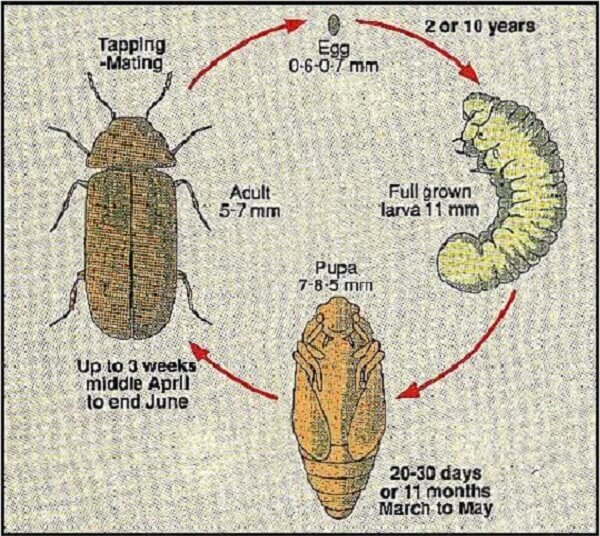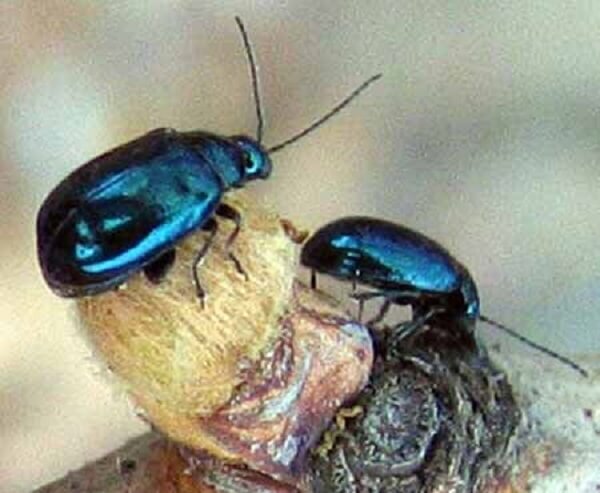Last week we looked at a few wood eaters, these woodworms who enjoy damaging your furniture, decking or flooring.
Building’s structural components and expensive antique furniture can be endangered by wood damaging pests. Wood pests have managed to develop an astonishing variety of life forms, as we have seen in the first part of this article. It featured the Wood boring Weevil, Bamboo Borer, Powderpost Beetle, Bark Borer and Common Furniture Beetle.
In this second part, we help you identify and learn about 4 more woodworms. You will then have a complete guide to fight with!
House Longhorn Beetle
Appearance
Adults: 8 to 25mm in length. These beetles are black or brown and covered with greyish hairs on the upper body and wing cases. There are two shiny black spots on the thorax which resemble eyes.
The fleshy larvae are greyish white and can grow to 35mm when fully developed.
Lifecycle
The female lays eggs in summer to early autumn in cracks and crevices of wood. They are yellowish to greyish white, elliptical with pointed ends, and hatch in two to three weeks. The larvae do the most damage, as they tunnel in the wood for between three and eleven years.
The larvae pupate near the surface of the wood and adults emerge after approximately three weeks.
Habits
It infests seasoned or partly seasoned softwoods. It usually damages sapwood but heartwood can also be affected.
Infestation takes place in isolated instances where infested packing case timbers have been transported.
Wharf borer
Appearance
The wharf borers are about 7–14mm in length with yellow brown with tips of elytra (wing case) black. They also have 3 ridges along the length of the elytra.
Lifecycle
· Eggs are laid on damp, decaying timber and larvae bore through wood for about 9 months then emerge in Summer.
Habits
Larvae require wood to be constantly wetted so that fungi break down the wood fibres.· Two main sources of infestation in buildings — structural timbers where rainwater leakage occurs, and pieces of timber buried below concrete foundations, paths and pedestrian precincts.
Deathwatch Beetle
Appearance
Adult Deathwatch beetles are 5 to 7mm in length; larvae - 10mm. · The beetles are dark reddish brown and have yellowish scale-like hairs on the upper body and wing cases. The larvae are a creamy white hook-shape covered in erect golden hairs with dark brown jaws on its head.
Lifecycle
· After mating, the female lays 3-4 eggs clustered in cracks of rough wood surfaces. They are whitish, oval shaped and she lays between 40 and 60 during her life. The eggs hatch within two to five weeks.
· The larvae pupate just below the surface of the wood. The adult emerges in early summer by gnawing through the surface and leaving the characteristic exit holes.
Habits
· In its natural environment the insect lives in the dead wood of several species of hardwood trees where fungal decay has set in.
· Within buildings the insect occurs almost entirely in old hardwood, in particular large oak timbers.
· The larvae do the most damage, as they tunnel in the wood for between five and ten years.
Steely Blue Beetle
Appearance
Adult Steely Blue beetles are about 4 mm with a Shiny blue colour.
Lifecycle
· Eggs are laid on the surface of wood by or just inside exit holes.
· Larvae live inside wood that has been infested by wood boring insects, where they feed on the larvae of these wood-damaging insects. Once adults they mate, lay eggs and then die.
Habits
· Predator of common furniture beetle and death watch beetle – so its presence indicates a heavy infestation of either wood-boring insect.
· It is the rarely seen larvae which consumes the larvae of the wood-boring pests in their tunnels. The steely blue beetle is not capable of damaging wood.
For most of the devils listed below, we recommend the natural treatment made by our friends from Freemite.
For more advice about how to get rid of wood borers, we suggest this well-written guide.





